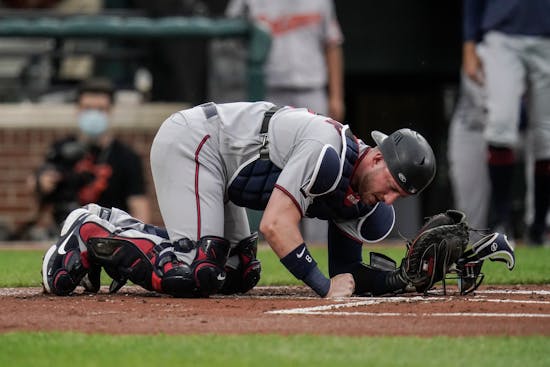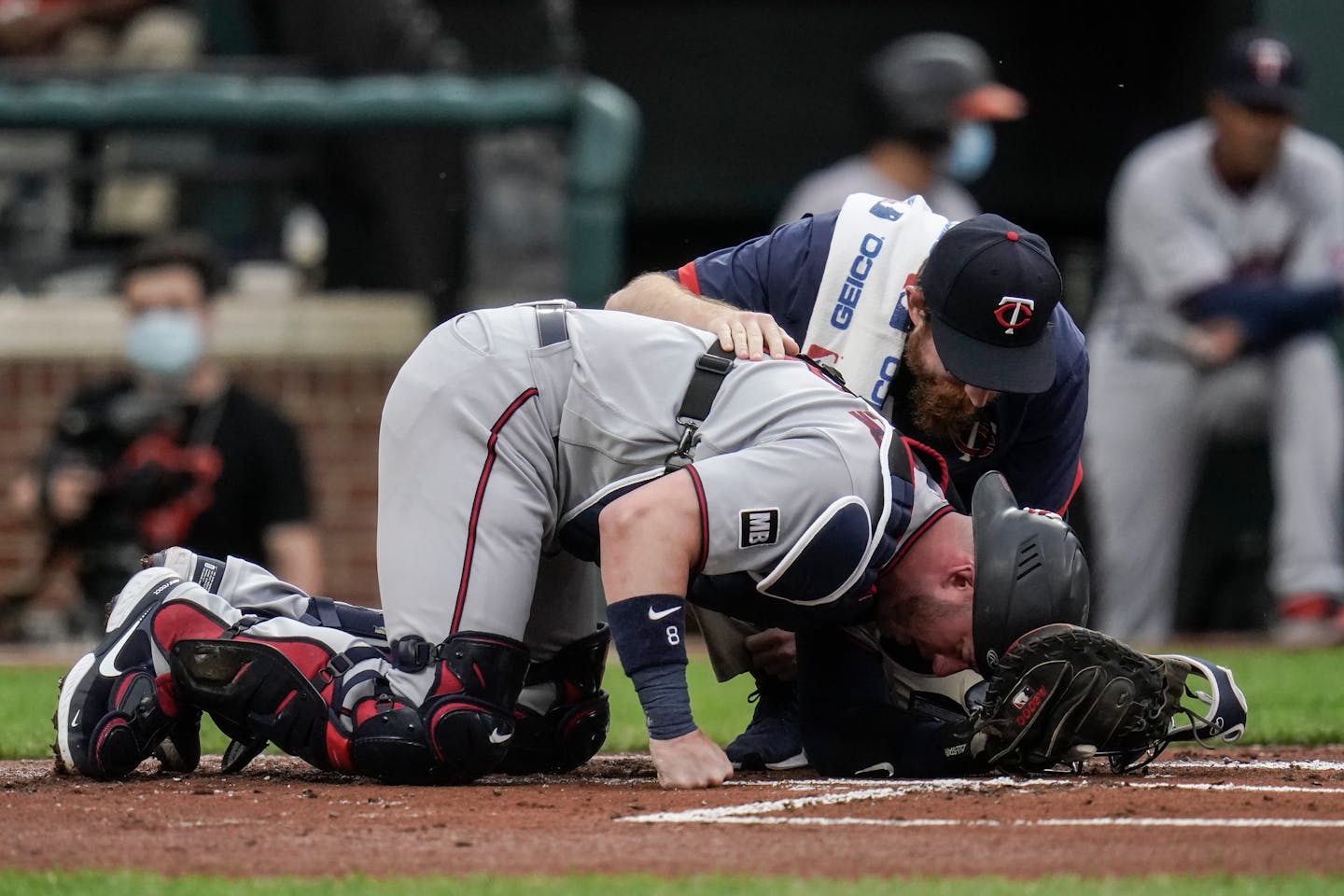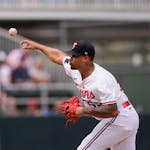 See
more of the story
See
more of the story
Mitch Garver took the phone and stared at the freeze frame on the screen for a few seconds.
A tweet showing a side-by-side comparison of him crouched in a traditional catcher's stance early in his Twins career vs. his revised "one-knee down" setup was meant to highlight his improvement in framing pitches low in the zone.
Something else caught my eye about that image, especially given Garver's current injury.
He is a sitting duck for foul balls. His legs and groin area are wide open, exposed without padding, basically a spread-eagle pose that says, "Here, hit me!"
"Yeah," Garver said, handing my phone back. "You're super exposed."
Garver is recovering on the injured list after being hit by a foul ball in his groin in early June. The forceful impact on his protective cup was such that Garver required surgery that night for what he describes as a groin contusion.
To be clear, the foul tip he took to his sensitive area almost certainly would have happened, too, if he had been positioned in a traditional catcher's squat. But the trendy one-knee setup that more catchers are using to improve their pitch framing comes with a trade-off. They are more vulnerable to foul balls drilling their lower body because their pads don't cover those areas in that elongated position.
"Protection gear wasn't built for this stance necessarily," Garver said. "I knew going into this in 2019 that, yes, you are going to be more exposed. That's just the nature of the beast."
Garver switched to having one knee on the ground after being ranked last among MLB catchers in pitch framing, largely because of low pitches. His analytics improved dramatically.
Catchers framing borderline pitches have become blatantly obvious with their quick, snatching motion. It's proven to be effective, though. Garver labels strikes at the bottom of the zone "the most valued strike in all of the game." Catchers conceivably would return to traditional stances if MLB institutes robo-umps to determine balls and strikes, thus eliminating the need for pitch framing deception.
Opinions differ on whether catchers on one knee block errant pitches as effectively as those in a traditional stance. Garver says his blocking analytics improved after he made the switch.
Garver sees another benefit with that stance. He is lower to the ground, which helps reduce the number of foul balls he takes off his face mask, potentially minimizing concussion risk.
"I always remember somebody telling me, the closer you are to the batter or the lower you are, the less likely you are to get hit in the face," he said.
Former Twins catcher A.J. Pierzynski said he tried to make himself "as small as possible" when squatting to reduce exposed areas. The one-knee stance does just the opposite.
"The nature of how guys are catching now, they're more exposed than they ever have been," Twins General Manager Thad Levine said. "If the intent of the equipment is to protect them, it's no longer achieving what it set out to do."
Garver wears Nike gear and said the company is developing new leg guards that will provide more knee coverage. The changes are more about natural advancements in equipment than a response to the one-knee setup.
The company that makes his face mask sent Garver a pair of compression shorts outfitted with Kevlar inserts on his thighs. Those have helped when he's been hit. Once he returns to action, he plans to wear a new model of protective cup worn by MMA fighters.
Ultimately, catchers accept a certain degree of occupational hazard. They can't wear full body armor. Foul tips are going to sting body parts.
Ryan Jeffers — Garver's replacement — sported a bruise above his right kneecap during batting practice last week. Nothing too bad, he said.
Sure enough, he took another foul ball to the same leg against the Yankees later that night. Next day, he had a discolored area the size of a softball on his thigh.
Pierzynski estimates that he got hit once a game by a foul ball during a 19-year career in which he caught in 1,936 games. That's a lot of baseballs ricocheting off his knees, wrists, face, thigh, feet, chest and, yeah, his cup.
"If there was a game where you didn't get hit," Pierzynski said, "the next game you knew you were in for three or four."
The law of averages seems particularly uneven in Garver's case this season. He's been a foul tip magnet.
"Unfortunately, Mitch has been in a rough run right now," Levine said.
Catchers and teams place so much value in pitch framing that going back to a traditional squat doesn't seem a consideration. Levine said the organization is hopeful that equipment manufacturers "can advance their development" to provide more protection with the new stance.
Garver needs more recovery time after a particularly painful blow. In his absence, Jeffers is sporting some fresh bruises on his legs, with more to come.
"It's just part of catching," Jeffers said. "You don't sign up to be a catcher if you don't want to get hit by a foul tip."








